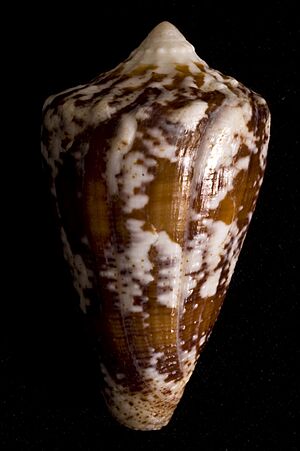Conus regius facts for kids
Quick facts for kids Conus regius |
|
|---|---|
 |
|
| Conservation status | |
| Scientific classification |
The Conus regius, also known as the "crown cone" snail, is a fascinating type of sea snail. It's a marine gastropod mollusk that belongs to the family Conidae. This family includes all the amazing cone snails and their relatives.
Just like other cone snails, the Conus regius is a predatory animal. This means it hunts and eats other creatures. These snails are also venomous. Because of their venom, it's very important to be careful around them. If you ever see a live one, it's best not to touch it at all. Their "sting" can be harmful to humans.
Contents
The Crown Cone Snail
Where It Lives
You can find the crown cone snail in warm ocean waters. They live in the Caribbean Sea and the Gulf of Mexico. You can also find them in the Atlantic Ocean near Brasil.
What It Looks Like
The shell of the Conus regius can grow up to about 7.5 centimeters (3 inches) long. It has a low, bumpy spire at the top. The sides of the shell are mostly straight. Near the bottom, you might see some faint lines.
These snails are known for their beautiful and varied shell colors. They are often chestnut brown with cool blue-white spots. But you can also find them in white, yellow-brown, or pale brown shades. The opening of the shell, called the aperture, is usually white inside. Sometimes it has chestnut-colored blotches.
Its Special Venom
The Conus regius produces a special type of venom. This venom contains tiny proteins called conotoxins. One of these, called reg2a, is very interesting to scientists. It's made of 16 tiny parts called amino acids.
Scientists are studying the venom from Conus regius because it might be useful in medicine. This snail is known to have more different conotoxins than many other cone snail species. Some of its venom components can block certain receptors in the brain. These receptors are important for how our nerves work. Researchers are looking into how this could help with things like nicotine addiction. The venom can also block calcium receptors in nerve cells, which stops nerve signals from traveling.
Where It Hides
These snails live in the ocean from the surface down to about 95 meters (312 feet) deep. They like to hide in these depths.
Gallery






